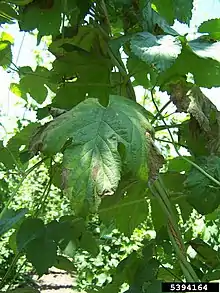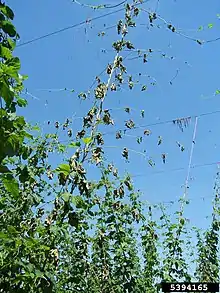| Verticillium nonalfalfae | |
|---|---|
| Scientific classification | |
| Kingdom: | |
| Division: | |
| Class: | |
| Order: | |
| Family: | Plectosphaerellaceae |
| Genus: | |
| Species: | V. nonalfalfae |
| Binomial name | |
| Verticillium nonalfalfae Inderbitzin et al. (2011) | |
Verticillium nonalfalfae is a soilborne fungus in the order Hypocreales. It causes verticillium wilt in some plant species, particularly Ailanthus altissima.[1][2] The fungus produces a resting mycelium characterized by brown-pigmented hyphae. It is most closely related to V. dahliae and V. alfalfae.[3]


Description
It is not possible to differentiate V. nonalfalfae and V. alfalfae from V. albo-atrum consistently using only morphological features. Verticillium albo-atrum may be found in co-infections with V. nonalfalfae on some hosts.[3] The hyphae penetrate the root epidermal cells of hosts and enter the xylem.[1][4]
Host and symptoms
Verticillium nonalfalfae has a wide host range including hops, kiwifruit, spinach, solanaceous plants like eggplants and potatoes, and tree of heaven (A. altissima). Systemic infections appear on most hosts showing vascular wilts caused by xylem blockage. Additional symptoms including vascular discoloration and defoliation show almost exclusively on A. altissima.[5][6] V. nonalfalfae tends not to infect non-target plants.[6] In contrast with V. alfafae, it does not infect alfalfa.
Impact on hops
One important host of V. nonalfalfae is hops, with infections found both in the United States and most places around the world.[7] The symptoms of hosts infected by V. nonalfalfae on hops are categorized into two pathotypes: mild and lethal. Mild pathotypes primarily cause symptoms of curling and leaf tissue death.[7] Hops infected by V. nonalfalfae with the mild pathotype generally can survive the infection. For the lethal pathotype of V. nonalfalfae on hops, hosts suffer from rapid weakening that ultimately leads to death. The lethal form was discovered in hops in the 1940s in the United Kingdom and elsewhere in Europe later.[8] Two pathotypes share similar peroxidase, which are thought to be contribute to their pathogenicity.
Disease cycle
The disease cycle of Verticillium nonalfalfae is similar to that of other members of the genus. V. nonalfalfae overwinters by forming a resting mycelium in the soil. However, unlike V. dahliae, for example, it does not produce microsclerotia.[9][3]
Verticillium nonalfalfae infects in the spring via conidia in the soil; conidia are borne on conidiophores.[9] It has been found that intraspecific grafting enhances V. nonalfalfae’s dispersal of conidia, that is, conidia from diseased roots can be transported to healthy root tissues.[10] Conidia can be transmitted through mechanical dispersal, whereby the conidia become attached to cutting tools. In the case of hops, the fungus can spread during soil cultivation, via plantings from infested yards, and through soil moved by equipment and workers. Long-distance transportation of conidia involves insects such as ambrosia beetles, which are thought to be critical in creating regional outbreaks of wilting in Ailanthus.[10][11]
Biological control of tree of heaven
Another important host of V. nonalfalfae is Ailanthus altissima, also known as tree of heaven. This species of Ailanthus was introduced in the northeastern United States from the 1790s, and is now a forest management problem in 40 of the 48 contiguous states.[11] Spreading widely and quickly, it is considered to be an Invasive species. V. nonalfalfae is being studied as a biological control of A. altissima. Symptoms of verticillium wilt on tree of heaven appear quickly after inoculation, according to studies.[10] A vector of the wilt is the weevil Eucryptorrhynchus brandti.[12]
.jpg.webp)
References
- 1 2 Kasson MT, Short DP, O'Neal ES, Subbarao KV, Davis DD (2014). "Comparative pathogenicity, biocontrol efficacy, and multilocus sequence typing of Verticillium nonalfalfae from the invasive Ailanthus altissima and other hosts". Phytopathology. 104 (3): 282–92. doi:10.1094/PHYTO-06-13-0148-R. PMID 24134719.
- ↑ Rebbeck, J.; Malone, M. A.; Short, D. P. G.; Kasson, M. T.; O'Neal, E. S.; Davis, D. D. (2013). "First Report of Verticillium Wilt Caused by Verticillium nonalfalfae on Tree-of-Heaven (Ailanthus altissima) in Ohio". Plant Disease. 97 (7): 999. doi:10.1094/PDIS-01-13-0062-PDN. ISSN 0191-2917. PMID 30722582.
- 1 2 3 Inderbitzin, Patrik; Bostock, Richard M.; Davis, R. Michael; Usami, Toshiyuki; Platt, Harold W.; Subbarao, Krishna V. (2011). "Phylogenetics and Taxonomy of the Fungal Vascular Wilt Pathogen Verticillium, with the Descriptions of Five New Species". PLOS ONE. 6 (12): e28341. Bibcode:2011PLoSO...628341I. doi:10.1371/journal.pone.0028341. ISSN 1932-6203. PMC 3233568. PMID 22174791.
- ↑ Progar, Vasja; Jakše, Jernej; Štajner, Nataša; Radišek, Sebastjan; Javornik, Branka; Berne, Sabina (2017-10-01). "Comparative transcriptional analysis of hop responses to infection with Verticillium nonalfalfae". Plant Cell Reports. 36 (10): 1599–1613. doi:10.1007/s00299-017-2177-1. ISSN 0721-7714. PMC 5602066. PMID 28698905.
- ↑ Flajsman, Marko; Mandelc, Stanislav; Radisek, Sebastjan; Stajner, Natasa; Jakse, Jernej; Kosmelj, Katarina; Javornik, Branka (2016-02-17). "Identification of Novel Virulence-Associated Proteins Secreted to Xylem by Verticillium nonalfalfae During Colonization of Hop Plants". Molecular Plant-Microbe Interactions. 29 (5): 362–373. doi:10.1094/MPMI-01-16-0016-R. ISSN 0894-0282. PMID 26883488.
- 1 2 Kasson, M. T.; O’Neal, E. S.; Davis, D. D. (2014-11-25). "Expanded Host Range Testing for Verticillium nonalfalfae: Potential Biocontrol Agent Against the Invasive Ailanthus altissima". Plant Disease. 99 (6): 823–835. doi:10.1094/pdis-04-14-0391-re. ISSN 0191-2917. PMID 30699540.
- 1 2 Mahaffee, W. F., Pethybridge, S. J., & Gent, D. H. (2009). Compendium of hop diseases and pests. St. Paul (Minnesota): The American Phytopathological Society.
{{cite book}}: CS1 maint: multiple names: authors list (link) CS1 maint: numeric names: authors list (link) - ↑ Jelen, Vid; Jonge, Ronnie de; Peer, Yves Van de; Javornik, Branka; Jakše, Jernej (2016-02-03). "Complete mitochondrial genome of the Verticillium-wilt causing plant pathogen Verticillium nonalfalfae". PLOS ONE. 11 (2): e0148525. Bibcode:2016PLoSO..1148525J. doi:10.1371/journal.pone.0148525. ISSN 1932-6203. PMC 4739603. PMID 26839950.
- 1 2 Inderbitzin, Patrik; Davis, R. Michael; Bostock, Richard M.; Subbarao, Krishna V. (2013-06-18). "Identification and Differentiation of Verticillium Species and V. longisporum Lineages by Simplex and Multiplex PCR Assays". PLOS ONE. 8 (6): e65990. Bibcode:2013PLoSO...865990I. doi:10.1371/journal.pone.0065990. ISSN 1932-6203. PMC 3688845. PMID 23823707.
- 1 2 3 O’Neal, E. S.; Davis, D. D. (2014-10-15). "Intraspecific Root Grafts and Clonal Growth Within Ailanthus altissima Stands Influence Verticillium nonalfalfae Transmission". Plant Disease. 99 (8): 1070–1077. doi:10.1094/pdis-07-14-0722-re. ISSN 0191-2917. PMID 30695945.
- 1 2 Swayne, Matt (8 May 2014). "Fungus may help stop invasive spread of tree-of-heaven". Penn State News. The Pennsylvania State University. Retrieved 28 September 2020.
- ↑ Snyder, A. L.; Salom, S. M.; Kok, L. T.; Griffin, G. J.; Davis, D. D. (9 August 2012). "Assessing Eucryptorrhynchus brandti (Coleoptera: Curculionidae) as a potential carrier for Verticillium nonalfalfae (Phyllachorales) from infected Ailanthus altissima". Biocontrol Science and Technology. 22 (9): 1005–1019. doi:10.1080/09583157.2012.707639. S2CID 85601294. Retrieved 7 June 2021.
Further reading
- Stajner, Natasa. "Identification and Differentiation of Verticillium Species with PCR Markers and Sequencing of ITS Region." Plant and Animal Genome XXIII Conference. Plant and Animal Genome.
- Inderbitzin, Patrik, and Krishna V. Subbarao. "Taxonomic challenges-molecular evidence for species and sub-specific groups in Verticillium." 11 th International Verticillium Symposium. 2013.
- Inderbitzin, Patrik, and Krishna V. Subbarao. "Verticillium systematics and evolution: How confusion impedes Verticillium wilt management and how to resolve it." Phytopathology 104.6 (2014): 564-574.
- Tyvaert, L.; França, S.C.; Debode, J.; Höfte, M. (2014). "The endophyte Verticillium Vt305 protects cauliflower against Verticillium wilt". Journal of Applied Microbiology. 116 (6): 1563–1571. doi:10.1111/jam.12481. ISSN 1364-5072. PMID 24905219.